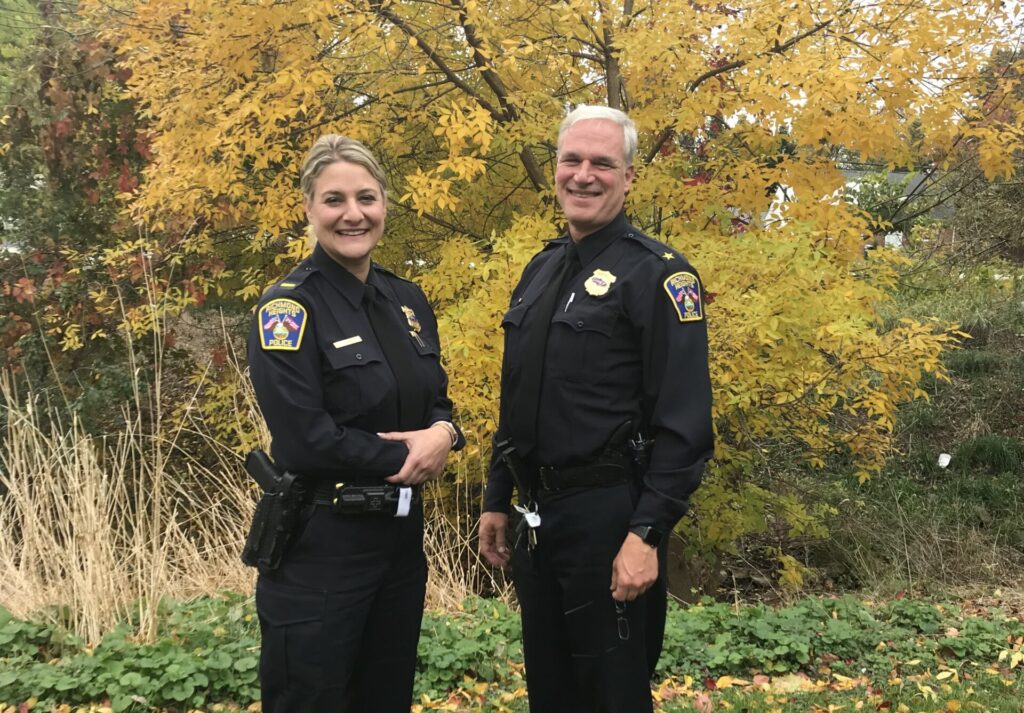
Features
Making our roadways safer: What can a cop do?
March 20, 2023 By Tom Wetzel and Denise DeBiase
 Chief Tom Wetzel and Lt. Denise DeBiase. Photo credit: Richmond Heights Police Department
Chief Tom Wetzel and Lt. Denise DeBiase. Photo credit: Richmond Heights Police Department As we approach Spring and warmer weather, we will start to see more pedestrians and cyclists out and about mixing in with the usual vehicular traffic we’re used to. Sunny days and snow-free roadways may cause some drivers to want to move quicker while they travel. As cops, one of our most important missions is to help maintain safe roadways so our customers can walk, bike and drive without getting injured, or worse.
Our communities probably think the only thing police officers do to help address traffic misbehavior is write traffic tickets. Yes, we do write traffic citations and it should be based upon the severity of the infraction, but we understand these enforcement actions have significant limitations on truly making a difference when it comes to safer travel. Simply put, we can’t cite our way to safety. It takes much more effort and resources, and the principles of community policing can be a critical component to help make that happen.
At a base level, a typical patrol officer has many different duties and traffic enforcement is one of them. An officer can position their cruiser in an area of high visibility and monitor traffic; this alone may have a preventive effect, as drivers may notice the cruiser and slow down if speeding or avoid running a red light. From there, an officer can observe traffic violations and conduct traffic stops. Depending on the severity and type of violation, an officer may give a verbal warning, a written warning, a ticket or make an arrest of the driver.
There are other measures, however, that police can take to be effective with traffic enforcement and monitoring driver behavior. One of them is by utilizing stationary speed signs. Speed signs are generally posted in areas where people have complained of excessive speeders. The speed sign not only lets the driver know how fast they’re going, but it also displays the speed limit for that particular street.
Cops can’t fix this problem alone.
In addition to speed signs, some jurisdictions use traffic cameras, which can be monitored either by an officer holding a speed device that houses a camera, or they can merely be stationed on a pole in complaint driven or accident-prone areas. Getting a ticket hurts a driver’s wallet, so this tends to curb behavior.
To further correct driver misbehavior, cities can opt to design traffic roundabouts or speed bumps to force drivers to slow down. Speed bumps are designed for residential and low speed roadways, while roundabouts keep traffic moving but force drivers to slow down and merge gradually into a traffic flow. Both speed bumps and roundabouts have been shown to be extremely effective in curbing speed and traffic crashes.
The most important thing to consider in these safety measures, however, is educating the public. Police, working in conjunction with their communities, have been educating the public since they were in pre-school through the program we fondly know as Safety Town. From a young age, kids are taught to know how to safely navigate traffic and it can continue into the teen years through other community programs.
Making our roadways safer to travel will definitely require a community policing mindset built on teamwork, partnerships, collaboration and a stronger appreciation towards safety from every driver and pedestrian using our roads and sidewalks. Cops can’t fix this problem alone.
Tom Wetzel is the chief of police in Richmond Heights, Ohio, a Northeast Ohio suburban police lieutenant and former SWAT commander. He is also a certified law enforcement executive, adjunct professor in community policing and internationally published author on police topics.
Lt. Denise DeBiase has been a member of the Richmond Heights Police Department in Ohio for over 26 years and is currently serving as the executive officer. She is a Certified Law Enforcement Executive in the state, former DARE, bike patrol, crime prevention, and juvenile diversion officer, and detective.
Print this page